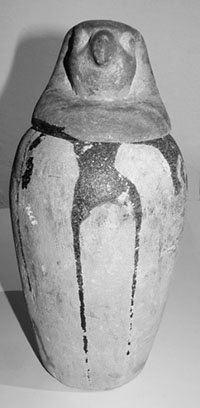Canopic Jars
General remarks on canopic jars
Text written by Michael Habicht, Egyptologist, April 2015
The jars have been used to store the viscera which were removed during the top quality mummification process. The real use of canopic jars is concentrated to the social elite, while the viscera remained in the body in cheaper mummification. The jars were protected by specialized deities: The Children of Horus:
- Amset protects the liver. Amset is human headed.
- Hapy protects the lungs. Hapy has the face of a baboon.
- Duamutef protects the stomach. Duamutef was jackal headed.
- Qebechsenuef protects the entrails. Qebechsenuef was falcon headed.
The removed viscera have been washed, dried in natron, wrapped and placed in the jars. Then often hot bitumen was poured over the viscera so seal them. During the funeral they were placed near the mummy.
Under the term ‘canopic equipment’ we can assemble several subcategories:
- Canopic block, mostly a calcite block which stores all 4 types of viscera. Example: the canopic Block of Queen Hetepheres I. (4th Dynasty)
- Canopic Jars, 4 separate jars with lid, often placed together in a canopic block made of wood or stone. About 85% of all canopic equipments fall in this category.
- Coffinettes, small miniature anthropoid coffins, containing the viscera, often placed in a canopic block. Example: The golden miniature coffins found in the tomb of Tutankhamun, made for a queen, secondarily used by Tutankhamun.
- ‘Internal canopics’ if the mummified viscera were packed back to the thorax of the mummy. This became tradition in the 3rd
Intermediate Period. In such cases, small figures, representing the
children of Horus were placed in the body in form of small statuettes.
During the Old Kingdom, the jars were simple in design and rarely inscribed. In the Middle Kingdom, the plugs are often human headed.
The peak of quality was reached in the New Kingdom. During the 21st Dynasty, the viscera were placed back in the abdomen, the jars become more and more dummy jars with ritual meaning only. The canopic jar had a revival during the 26th Saïte Dynasty, from this period we have a greater number of canopics, but only from unknown or insignificant people. During the Greek-Roman period, the use of canopic jars disappeared.
Further reading
- Frank J. Rühli, Michael E. Habicht, Abigail S. Bouwman, Die Bedeutung von Kanopen als Quelle medizinischer und ägyptologischer Information, Göttinger Miszellen 237, p 25-39, 2013.
- Rühli F, Bouwman A, and M E. 2014. “Canopic Jars: A New Source for Old Questions.” In: Egyptian Bioarchaeology. Humans, Animals, and the Environment, edited by Salima Ikram, Jessica Kaiser, and Roxie Walker. Leiden: Sidestone Press. http://www.sidestone.com/library/egyptian-bioarchaeology.
- Andreas G. Nerlich, Judith Falter, Albert Zink, Why did the Egyptians Use Natron for Arteficial Embalming? – An Experimentals Study on Organ Mummification. J. Biol. Res. 2005, Vol LXXX, S. 164-166.
- Aidan Dodson et al., The canopic equipment of the Kings of Egypt (1994). Keagan Paul International London New York.
- Taylor J H, 1999. “The Burial Assemblage of Henutmehyt: Inventory, Date and Provenance.” In Studies in Egyptian Antiquities: A Tribute to T. G. H. James, edited by W. Vivian Davis, 59–63. London: British Museum.
- George Andrew Reisner, Canopics (1967, revised by Mohammad Hassan Abd-ul-Rahman). Le Caire: Impr. de l’Institut français d’archéologie orientale.
- Rolf Krauss, Kija, die ursprüngliche Besitzerin der Kanopen aus KV 55, MDAIK 42, 1986, S. 67-80.
- Alfred Lucas, The Canopic Vases from the „Tomb of Queen Tîyi“, ASAE 31, 1931, S. 120-122.
